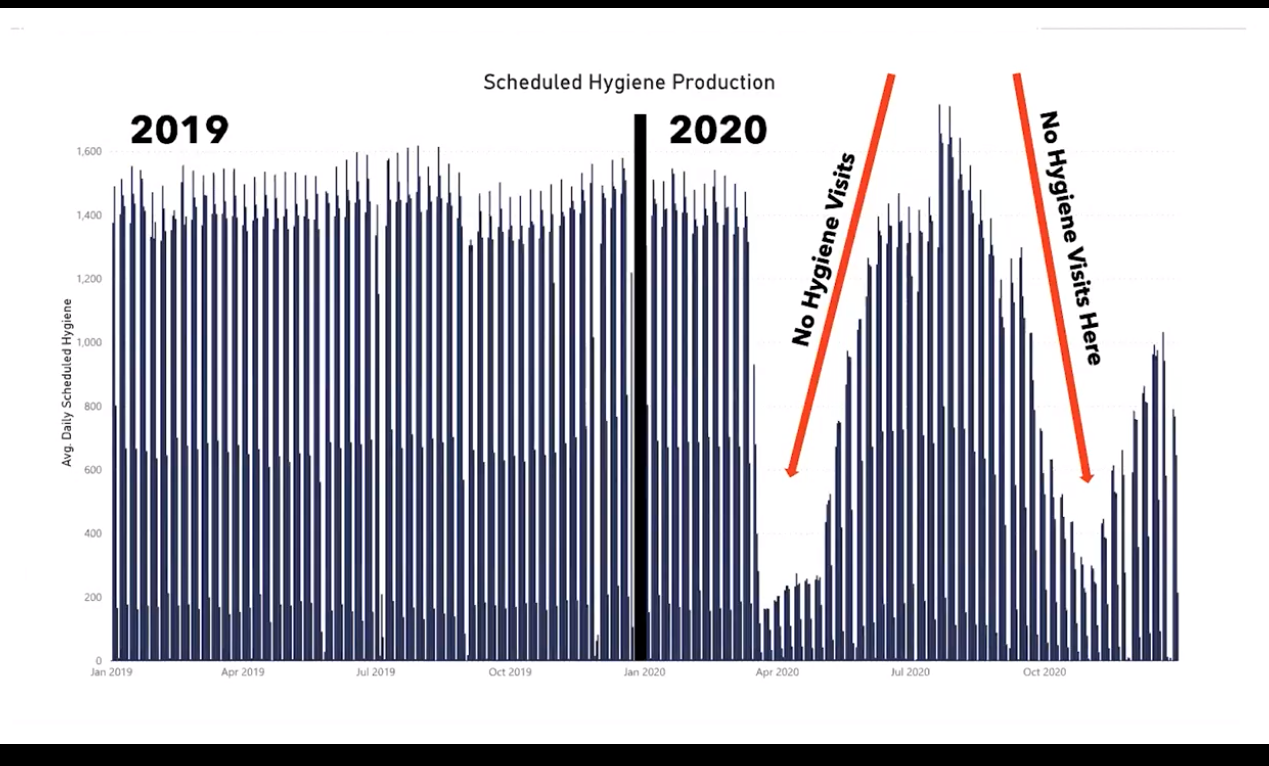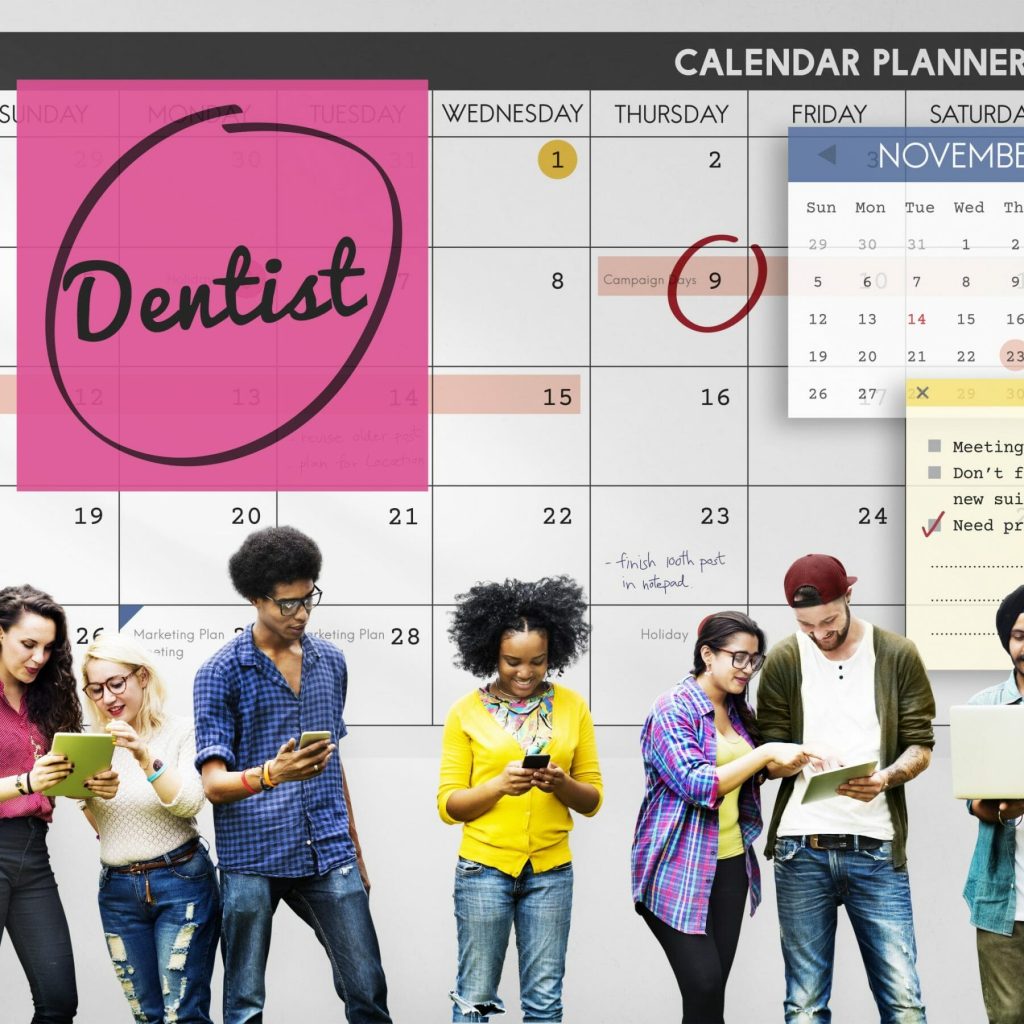It has been nearly six months since dental offices were forced to close their doors to non-emergency dental patients. Little to no hygiene appointments this spring, means fewer follow-up hygiene appointments six months later. This presents a potentially revolving problem every six months if your patients aren’t scheduled for their routine hygiene appointments.
Steven Jensen of Dental Intelligence shares insight into the visual “dip” observed in hygiene production for 2020 due to COVID-19.

This chart illustrates “scheduled hygiene production” for the dental industry as a whole, but “actual” hygiene visits were likely even lower than what is shown here.
IDENTIFYING THE PROBLEM FOR YOUR DENTAL PRACTICE
When considering how to best mitigate this hygiene appointment drop off, the first step is becoming aware of what this problem looks like for your practice individually.
- Identify your practice’s average number of hygiene visits per month. The industry standard is typically 250 appointments per dentist. But also consider the size of your practice, the number of hygienists on staff, and your community.
- Identify how many hygiene visits you already have scheduled.
- Calculate how many more hygiene visits you need to schedule – taking into account the current openings in your schedule. This should give you your practice’s “hygiene gap.”
YOUR DENTAL PRACTICE GAME PLAN
Once you’ve discovered your practice’s “hygiene gap,” you’ll need to create a strategy for filling in your schedule.
“The first step is developing a game plan to mitigate this issue and get people back in your doors,” says DentalHQ founder Brett Wells.
Start scheduling hygiene appointments by reaching out to your inactive or past-due patients. When pulling this list, Wells recommends reaching out to patients as far back as the past three years. These are the patients that have been to your practice and are familiar with you, but have fallen off their 6-month recall visits.
However, a reactivation strategy should not be limited to patients in need of a hygiene check-up. Remember to also contact any patients with unscheduled treatments like crowns, implants, and fillings; or patients who have unused insurance benefits. According to Sandy Pardue of Classic Practice Resources, most dental offices have 800-1,000 patients that are due for recall. It’s up to you and your team to reach out and get them back into the dental chair.
“Every practice should be doing a reactivation project each January,” says Pardue. These special circumstances caused by COVID-19 calls for an extra reactivation project this fall. But what communication strategies work best? And how can your practice implement them efficiently?
COMMUNICATION METHODS FOR THE REACTIVATION PROCESS
It’s imperative to diversify your forms of communication when reaching out to your patient base. Using one method exclusively will become “white noise” and get ignored over time. For example, sending automated emails and texts to a patient that’s been inactive for over a year may not be as effective as other communication channels. Let’s explore other ways to get your outreach efforts noticed.
Phone Calls
When reaching out to your patient list via phone, delegate the communication list between team members. Doing it in bite-size chunks will make it less overwhelming. Especially for your front office workers who are already doing more than usual during the check-in process.
Make sure your team members sound interested and upbeat during these phone calls, while still matching the tone of the person on the other end. “Sometimes the team member’s tone is more important than what they say,” according to Pardue.
For ideas on what to say during these calls, see our blog on COVID Scripts and Patient Talking Points.
Postcards
Postcards are a unique communication method because they serve as a physical reminder to schedule with your practice. For your reactivation strategy, Pardue recommends sending postcards three months in a row to the same group of people.
This communication method allows you to include something only a postcard can provide: an address update request with the message “return service requested”. In receiving this request, you will learn who is in the household, their ages, and any family member changes or updates. Use this postcard approach every year and let this be part of your list-cleaning strategy.
What Else Should You Include in a Postcard?
Pardue recommends one side of the postcard include a picture of your dental team, your sign, or your office. She also suggests testing what colors get the best response from your audience. “Highlighter green” was found to be effective for Pardue’s team, but consider your brand colors in the design as well.
Make patients aware of the health risks involved in putting off procedures – even routine cleanings. We know dental health is closely linked to overall health. Regular dental visits are imperative in ensuring small cavities don’t become root canals, and root canals don’t become extractions.
Wells recommends including a “COVID Comeback Coupon” for anyone who comes back between September 21 and Thanksgiving. This can be adjusted to the date range that best suits your practice’s needs.
COMMUNICATION ON YOUR WEBSITE AND BEYOND
Overall, your website and social media channels should focus on rebuilding trust and getting your patients comfortable with returning to the dentist. Meet the patients where they are by making it easy for them to schedule appointments online, find your contact form, or get their questions answered via live website chat.
A big step in building trust with your patients is being transparent about the COVID precautions you’re taking in your office. Even if it is sanitization and sterilization procedures you have always done before COVID, making your patients aware of everything you’re doing can help them feel better about scheduling an appointment with you.
Sharing this information with them on your website and social media channels can help build confidence in your practice’s ability to keep them safe. Many of our clients have added COVID Sterilization pages to their website that fully explain the measures dentists are taking to ensure safety and what their patients can expect.
For more ideas, check out our recommendations for your COVID-19 Marketing Checklist.
THE BOTTOM LINE
The shock waves of COVID-19 continue to affect dental practices months after reopening their doors. Without a reactivation strategy, this problem is set to recur every six months. You can mitigate this risk by:
- Identifying what the problem looks like for your individual practice.
- Developing a game plan to reach out to patients that are inactive for up to three years.
- Identify how many hygiene visits you already have scheduled.
- Diversifying your communication methods to stand out and get noticed.
- Sharing consistent and comforting messaging on your website and social media.
If you would like help creating and implementing these communication strategies please contact us today. We are here to help.

